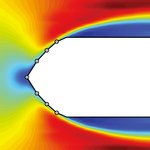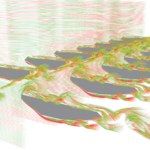
The reliability of traffic infrastructures is a key factor in the performance of Germany as a business location. Bridges in transport networks are critical elements that are permanently exposed to high loads. Their inspection is currently being carried out by local experts. Major problems at highway bridges have recently highlighted the importance of early detection of aging damage to be able to take conservation measures before it is too late.
Project data sheet | Project website

The aim of »smood« is the modification of existing urban quarters with a high level of local self-sufficiency of renewable energies in terms of energy and warmth-neutral. The experts in »smood« are combining recently developed technologies for energy generation and storage with established technologies such as photovoltaics, solar thermal energy or geothermal energy to create an optimized system. The related departments at the Bauhaus-Universität Weimar, Modeling and Simulation (Prof. Dr. Guido Morgenthal), Building Physics (Prof. Dr. Conrad Völker) and Computer Vision in Engineering (Prof. Dr. Volker Rodehorst) are working together on the subproject »smood PLAN - Neighborhood Data Acquisition and Processing«.
Project data sheet | Project website

Potentials for thermal-energetic optimisation are especially given by buildings which are restricted to a low energy-efficiency by their remaining lifetime or their cultural value. Extending the view from the single building to a city quarter leads to a carbon-footprint influenced by the interactions of the entire cluster. The campus of the Bauhaus-Universität Weimar including historical buildings distributed over several city quarters is an excellent object for an exemplary case study. The research approach considers potentials of the building surface and (urban) energy systems, advantages of a functional combination as well as the integration of protected historical buildings into concepts of sustainable urban development supported by building registrations via unmanned aircraft vehicles.
Project data sheet
Global warming and the resulting associated changes in the climate system increase the risk for harmful consequences for safety and resilience of built environment. Sustainable structural adaptations to climate change through engineering measures can lead to a reduction of the vulnerability of structures and their exposure to climate changes. This project involves several chairs from BUW with the aim in working together towards a strategy of assessing the climate change models along with their consequences for structural safety and indoor climate, by analyzing certain reference objects.

The fundamental goal of this project is to develop a generally applicable methodological framework, which
makes it possible to evaluate the forces in structures due to complex dynamic wind-induced phenomena.
This shall be carried out by means of numerical simulations considering defined limit states and to optimize the structure on the basis of probability of occurrence or degree of utilization.
Project data sheet

In recent years, the conversion of the unstable response of thin-walled structures due to aeroelastic instabilities is a practical approach for small-scale energy harvesting. The aim is to supply sustainable green power for wireless sensor networks, portable and wireless electronic devices, especially those expected to operate for a long time with no human intervention.
Project data sheet
In the future, digital methods supporting the planning of construction and maintenance of buildings and city quarters should optimise the process. The multidisciplinary research project at the Bauhaus-Universität Weimar applied Unmanned Aircraft Vehicle (UAV) based image acquisition for an automated damage detection on existing structures (Computer Vision), the thermal-energetic evaluation of buildings using thermal images (Building Physics), the sensor based monitoring of characteristic values and the consistent and linked data storage in Building Information Models (BIM). The included research on sensor networks was done by the Institue for Micro-electronik and Mechatronic Systems (IMMS) from Ilmenau.
Funding period: 11/2016 - 2/2019
Funded by: Freistaat Thüringen and European Social Fund
Contact: guido.morgenthal[at]uni-weimar.de

Within this research project, scientific questions and application-related issues in connection with the use of cost-effective inclination sensors and microcontrollers have been addressed. The aim was to develop a sensor-based monitoring system that can be utilized for structural health monitoring. Sensors based on novel MEMS technology and modern microcomputer form the basis of the innovative monitoring system. Thereby, local rotations on the structure are measured to monitor the system behavior and detect critical structural states. First, the effective resolution and the achievable data quality of the sensors has been quantified by extensive laboratory experiments. For the application on structures, sensors were integrated in suitable housings and the influence of the encapsulation has been studied. A prototypical measuring system based on a Raspberry Pi and a dedicated modular software framework was developed in several stages for the acquisition, processing and evaluation, storage and transmission of the measurement data. In order to demonstrate the practicality, the measurement system has been applied at two reference objects: an industrial hall where the roof structure was to be monitored and a church tower where the long-term change of the tower inclination was to be observed. Thereby, the application potential as well as the limits of the monitoring systems have been demonstrated.
Funding period: 10/2015 - 11/2017
Funded by: Forschungsinitiative ZukunftBau
Contact: guido.morgenthal[at]uni-weimar.de
Report

Unmanned Aerial Vehicles (UAV/ UAS) for Condition Assessment of Structures – Continuation Project
The previous project "Unmanned Aerial Vehicles (UAV/ UAS) for Condition Determination of Structures " (SWD-10.08.18.7-13.05) had investigated academic questions in relation to the application of UAS in the proximity of structures. The aim of this continuation project was the optimisation of the UAS navigation for a highly efficient and reproducible generation of photo and thermographic images with UAS for condition assessment of structures. As part of the research project, a method and a prototype software implementation the computation of georeferenced flight routes for UAS based on existing building information models (BIM) or rough 3D models has been developed, which guarantees a complete coverage of the structure. UAS-based condition determination can be an important part in the digital chain of structural monitoring using other innovative methods and technologies from the fields of computer vision, virtual reality or artificial intelligence. However, there is a need for further research, especially on the part of data analysis and context-related data modelling.
Funding period: 01/2017 - 06/2018
Funded by: Bundesamt für Bauwesen und Raumordnung -BBR-, Bundesinstitut für Bau-, Stadt- und Raumforschung -BBSR-, Forschungsinitiative 'Zukunft Bau'
Contact: norman.hallermann[at]uni-weimar.de

In this research project, academic questions in relation to the application of UAVs for condition determination of structures were investigated. With the help of specific investigations on selected reference objects, the potential of these systems should be initiated for a cost-efficient inspection of structures. The research focused on the quality assessment of the generated image and video data for the identification of typical damages on structures and the further applicability. Professional high-end UAVs equipped with high quality cameras are generally well suited for visual and even survey based condition determination of structures based on high resolution image and video data. Particularly in the determination of the condition and periodical inspection of very large, high and hard to access structures, these systems could make an essential contribution to an increasing efficiency and cost reduction. The use of such systems could lead to an explicit simplification and acceleration of data acquisition processes and could essentially support the process of data capture, evaluation and documentation in relation to the condition of the structure.
Funding period: 06/2013 - 04/2015
Funded by: Bundesamt für Bauwesen und Raumordnung -BBR-, Bundesinstitut für Bau-, Stadt- und Raumforschung -BBSR-, Forschungsinitiative 'Zukunft Bau'
Contact: norman.hallermann[at]uni-weimar.de

A novel numerical method was developed for the fluid flow analysis of bluff bodies at high Reynolds Numbers. Specifically, the method allows pseudo-3D simulations of fluid–structure interaction phenomena of line-like structures under the influence of incoming turbulence. The method is based on the Vortex Particle Method (VPM) and enjoys a high computational efficiency which renders it applicable to the analysis of numerous problems in wind engineering.
Funding period: 2013 - 2017
Funded by: Deutsche Forschungsgemeinschaft (DFG)
Contact: guido.morgenthal[at]uni-weimar.de

Within this research project, methods for the efficient numerical simulation of wind flows around buildings will be developed. They should take account of the peculiarities of such flows, in particular the characteristics of high Reynolds numbers, the very different spatial scales, the complexity of the body geometries and the influences of possible structural vibrations.
Funding period: 2012 - 2016
Funded by: Deutsche Forschungsgemeinschaft (DFG)
Contact: guido.morgenthal[at]uni-weimar.de



